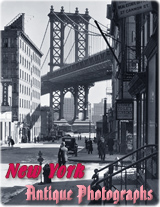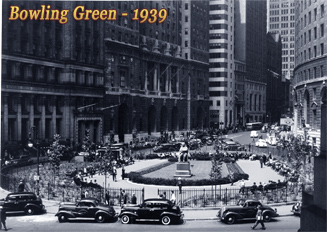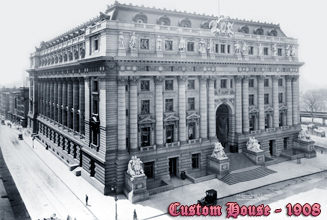Bowling Green is the oldest public park established in New York City. During the Dutch rule it marked the beginning of the Heere Staat ("High Street", now Broadway). The area was a parade ground and marketplace. On April 27, 1686, the site was designated as property under municipal domain by the Dongan Charter.
On March 12, 1733, a piece of land lying at the lower end of the Broadway, fronting to the Fort, was leased to make a bowling green, with walks therein for the recreation and delight of the inhabitants of the City. Before that, there was the Bowling Green Garden in Greenwich Street, between Warren and Chambers streets.
The shape of the Bowling Green was trapezoidal until about the 1780s, when it gained its oval shape. The wrought iron fence that surrounds the park was installed in 1771 to protect the statue of King George III, erected by the British government on March 21, 1770. This statue was pulled down, in 1776, following a reading of the Declaration of Independence. In April, Washington set up headquarters at the Kennedy Mansion, in the same site the Washington Building, opened in 1884. Many buildings in the area were destroyed by the Great Fire of September 1776, after the British invasion. The fence was repaired in 1786.
In 1790, the Government House was erected at the foot of Broadway, south of Bowling Green, on the site previously occupied by Fort George in Manhattan. The Government House was demolished in 1815. Today, the site is occupied by the Custom House completed in 1907.
Before 1844, a decorative fountain was installed in the center of the Park. It was removed in the reforms of the late 1930s and reinstalled about 1977.
The Great Fire on July 19, 1845 destroyed many buildings in the area. The Adelphi Hotel, one of the tallest commercial buildings in the City, with six floors, was consumed by fire (on the right in the picture below).
 In 1896, it was installed in the Park a
monument to Abraham de Peyster, New York’s mayor (1691 to 1694), by the
artist George Bissell. The statue was removed in 1972.
In 1896, it was installed in the Park a
monument to Abraham de Peyster, New York’s mayor (1691 to 1694), by the
artist George Bissell. The statue was removed in 1972.
The 16-story Bowling Green Offices Building, 11 Broadway, was erected between 1895 and 1898. Five additional stories were built in 1920–1921. The 23-story Standard & Poor's Building (now Cunard Building) at 25 Broadway, was erected between 1920 and 1921.
In the 1930s, the Park was rebuilt. In 1976, Bowling Green was restored to its 18th-century appearance. A new fountain was installed in 1977. In 1989, the Park received a bronze sculpture of a Charging Bull, representing aggressive financial optimism and prosperity.









































